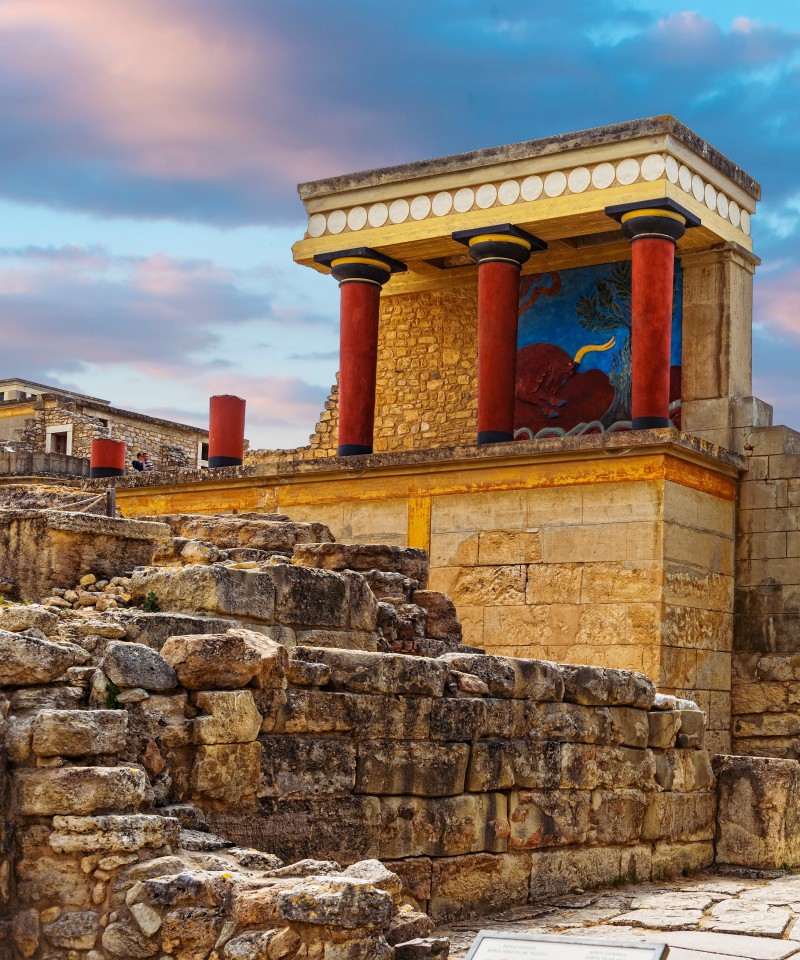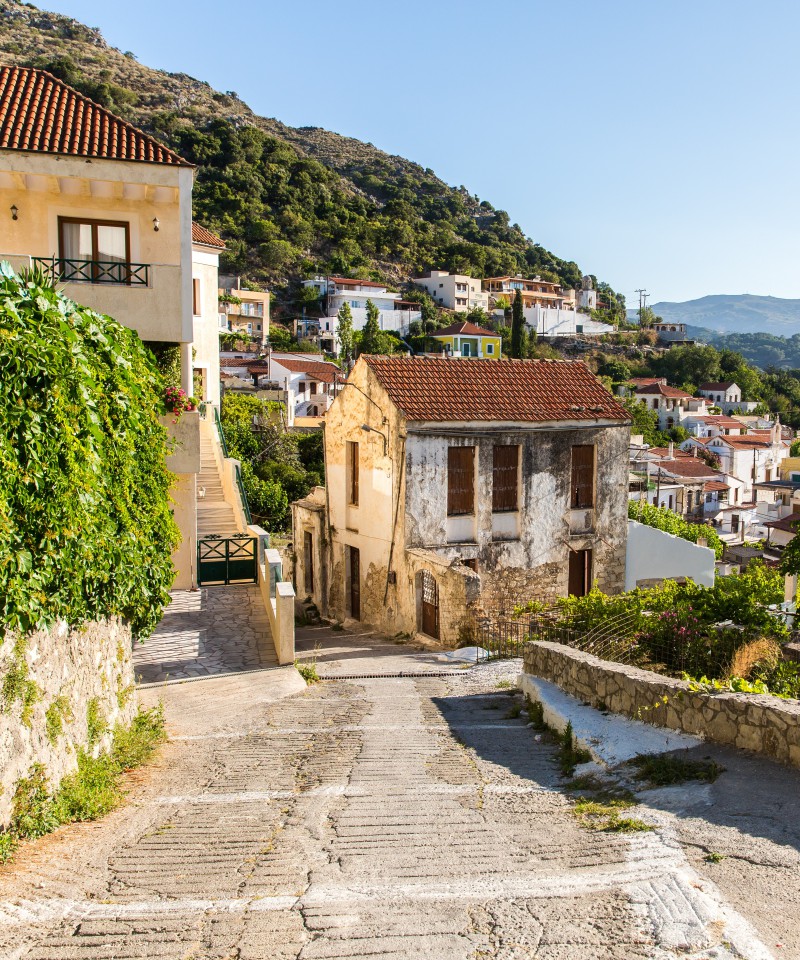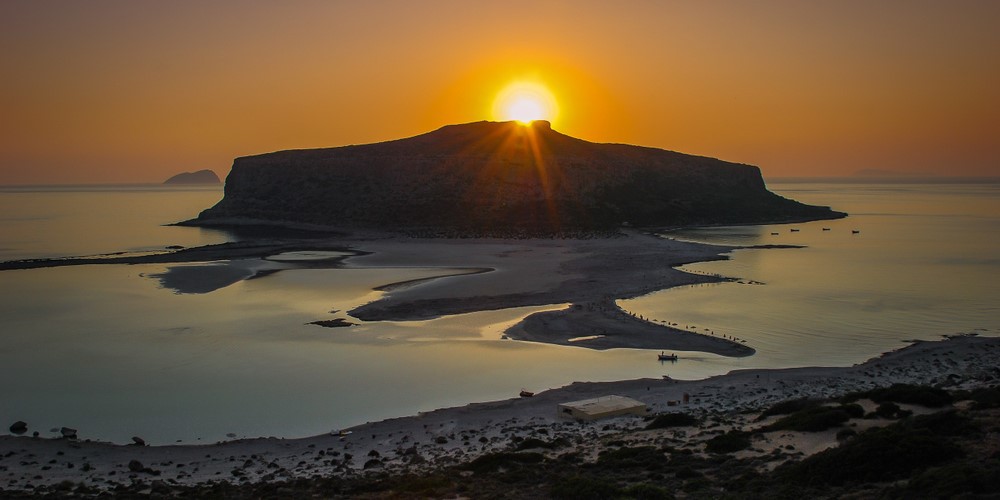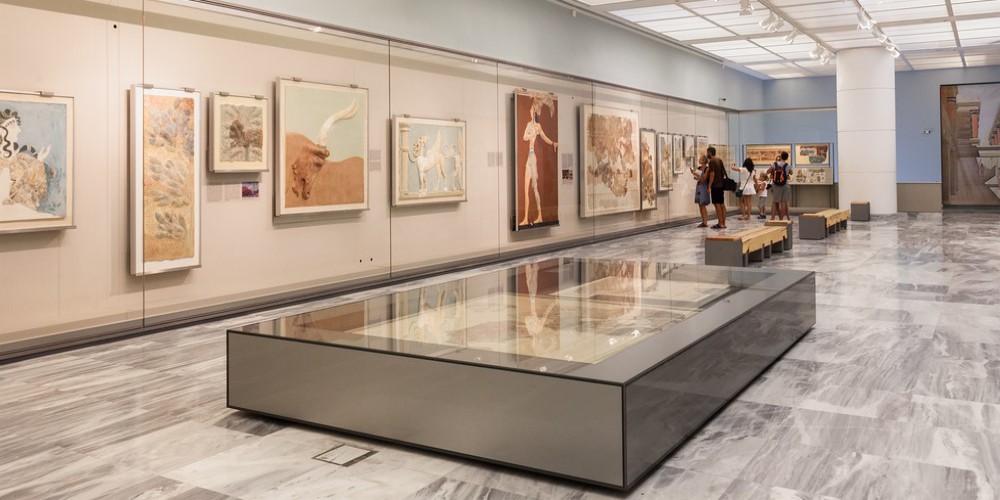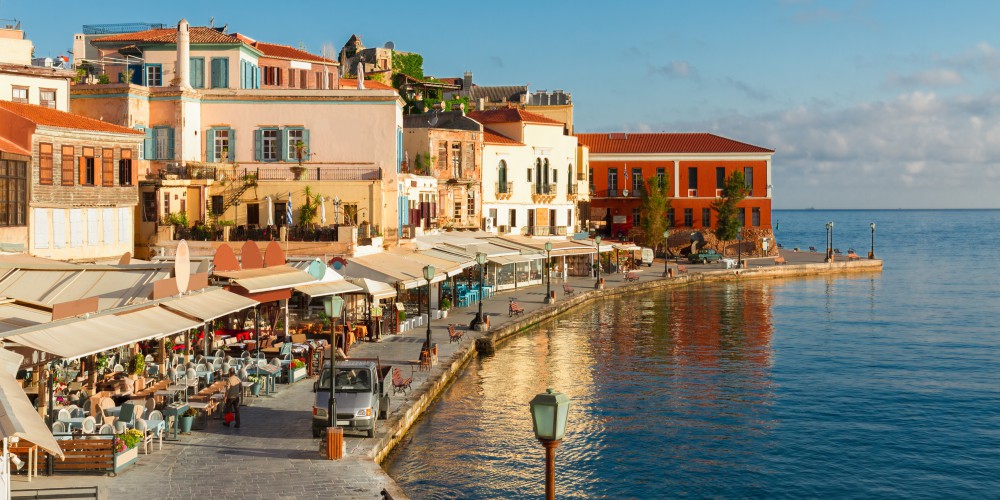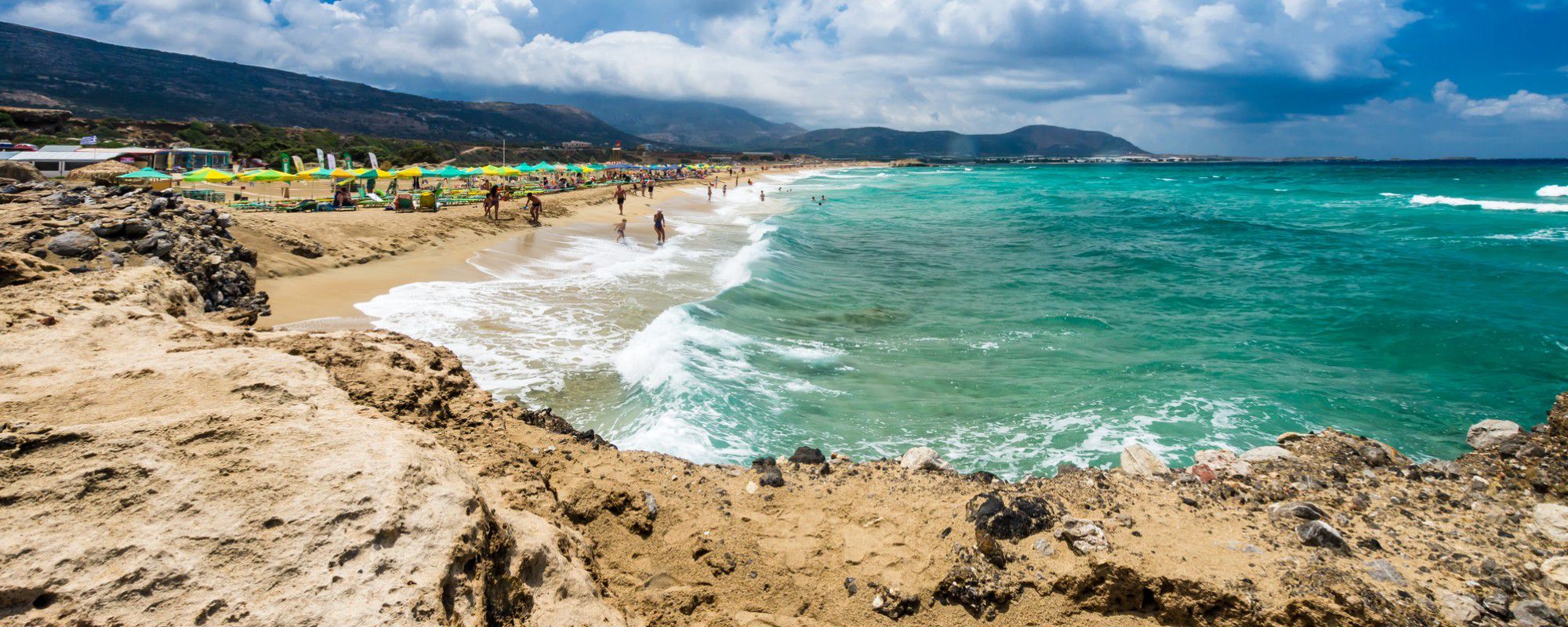
Discovering Crete, Greece's Largest Island
Key Takeaways
- Crete is the largest island in Greece located in the southernmost part of the country between the Cretan and Libyan seas.
- The Minoan civilization, which thrived between 2800 BC and 1400 BC, played a significant role in the island's history.
- Crete offers a mix of intense cosmopolitan life and a calm island atmosphere.
- Crete is divided into four Municipalities: Heraklion, Lassithi, Chania, and Rethymnon.
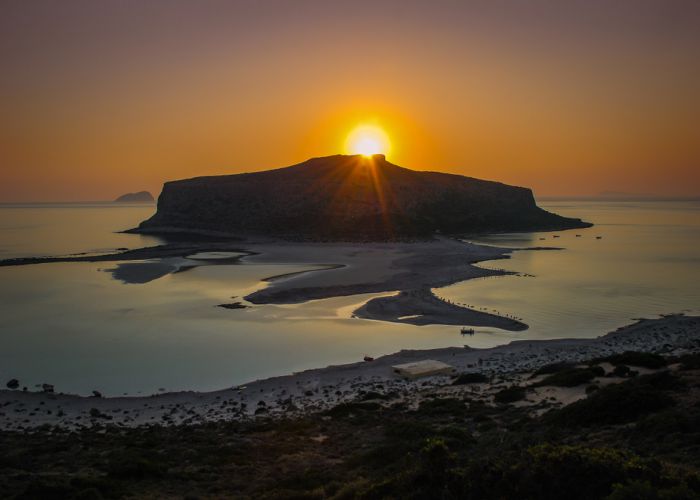 Balos Lagoon during sunset - credits: natalyphotography/Shutterstock.com
Balos Lagoon during sunset - credits: natalyphotography/Shutterstock.com
The beautiful island of Crete happens to also be the largest Greek island, located at the southernmost tip of Greece between the Cretan and Libyan seas.
It is one of the most popular tourist destinations visited by thousands of travelers from around the world, and the reasons why are obvious to visitors as soon as they reach the picturesque port of the island.
Crete consists of four Municipalities: Heraklion, Lassithi, Chania, and Rethymnon, while it is surrounded by dozens of small islands, of which only four are habitable.
The capital of the island is Heraklion, surprisingly one of the largest cities in Greece, which is in no way, shape, or form inferior to the main cities of mainland Greece at any front.
In addition to its undeniable natural beauty, however, Crete has a long-standing history that makes it fascinating and culturally rich.
You will witness it from the moment you arrive from Athens to Crete or any other destination in Greece, such as Santorini to Crete.
Crete was first inhabited during the Neolithic Age and reached its peak in the Minoan years when the Minoan civilization flourished between 2800 BC and 1400 BC, mainly during the dynasty of King Minos.
It was then that the island suffered severe damage from the eruption of the Santorini volcano, which later resulted in Crete being an island with countless changes in landscapes.
There, the wild face of the mountain scenery is perfectly combined with the colorful paradise of flowers and the green plains.
In recent years, the combination of intense cosmopolitan life with the calm and serenity of the island’s atmosphere only add to Crete’s appeal, making it a sought-after destination for Greeks and foreigners alike.
Those who love the crowds will find many organized sandy beaches with crystal clear waters that attract many bathers.
At the same time, lovers of tranquility can head to the various secluded beaches of the island and relax while marveling at the nature that surrounds them.
In Crete, there are many Venetian castles, secluded churches, monasteries, museums, and ancient ruins.
These, together with the beautiful enchanting scenery that dominates the landscape everywhere, will make your vacation unforgettable.
Due to its large area, a single visit to the island is not enough to explore it. That’s why here we’ll introduce you to the main regions of Crete.
Please remember that every time you return to Crete, you will discover new beauties that will fascinate you!
Heraklion
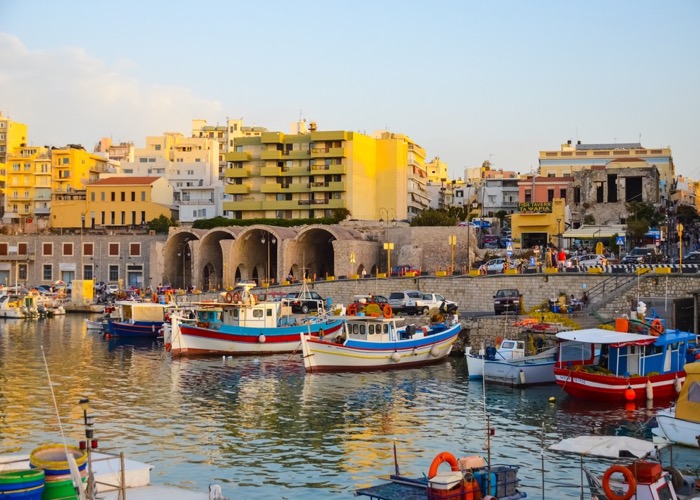
The prefecture of Heraklion is located in the center of Crete with its capital city, Heraklion, being one of the largest cities in Greece, counting around 250,000 permanent inhabitants.
It is surrounded by the mountains Psiloritis and Lassithiotika and perfectly combines both mountain and sea views.
On its premises lies the busiest airport in Crete, which accepts both international and domestic flights.
The first impression of visitors, when they arrive in Heraklion, can be a bit less than great, as it is a noisy big city whose appearance does not resemble much of an island.
However, looks can be deceiving, as one will discover when getting to see the beauties and the charm that this unique region of Crete hides.
The history of Heraklion begins thousands of years ago. The prefecture of Heraklion hosts the famous Minoan palace of Knossos, known for the famous legend of Theseus and the Minotaur.
Knossos Palace and the Heraklion Archaeological Museum are two of the most important historical sights of Crete, which is why they receive a large number of visitors every year.
Heraklion consists of Old and New Towns. Nea Poli has been the capital of the prefecture since 1972, an important economic center that contributes significantly to the trade and industry of Crete.
The part of the Old Town is located between the old walls forming a triangle whose base overlooks the sea, and its top meets the Martinengo bastion at the highest point of which is the tomb of the famous writer Nikos Kazantzakis.
The picturesque Venetian port of Heraklion is ideal for endless morning or evening walks and is the best place to enjoy the wonderful view around the castle walls.
A short distance from the Venetian port lies the Historical Museum of Heraklion which was founded in 1952 by the Research Institute of the History of Crete.
The museum houses many important exhibits and archaeological finds which depict various phases of Cretan life starting from the beginning of the Christian period.
Those who visit Heraklion have the opportunity to wander the streets of the Old Town and visit some of the ‘hidden gems’ of the area.
Some of them include the picturesque square of Eleftherios Venizelos full of cafes, restaurants, and tourist shops, and the Morozini Fountain.
The latter is known as ‘the Fountain of the Lions,’ which was built in 1628 by the then Governor of Crete Fratzesco Morosini.
Apart from the Old and New Towns of Heraklion, in the prefecture, there are many beautiful areas to visit.
As you go south of Heraklion, you will meet enchanting beaches with crystal clear waters as well as hospitable and very friendly residents.
One of the most interesting sights of the area is the famous Aquarium of Crete which is located between the city of Heraklion and the tourist resort of Hersonissos.
It hosts 2500 living marine organisms that include a wide variety of fish, sharks, shellfish, jellyfish, and other beautiful species of the seabed.
The Aquarium is open to the public daily all year round and receives thousands of visitors of all ages.
The prefecture of Heraklion, starting from the cosmopolitan coastal resort of Hersonissos, and reaching the archaeological sites of Archanes and Pyrgos, is one of the most remarkable destinations in Crete that you should not miss to visit.
Organize your vacation time and spend a few days in Heraklion; you won’t regret it!
Lassithi

The prefecture of Lassithi is the easternmost prefecture of Crete perfectly combining mountain and sea with the lush plain of Lassithi stretching between the imposing mountains that surround it.
Apart from the picturesque capital of Agios Nikolaos, Lassithi offers beautiful villages and settlements for holidays such as the busy tourist resort in Malia, the famous Elounda, the city of Sitia, and the popular palm forest Vai.
In Lassithi, the soil is one of the most fertile in Crete and for this reason, the cultivation of potatoes and apples has been greatly developed through the years.
The banana production industry is also developing as many plantations of this kind are spread in the southern part of the prefecture.
Since 1904, the capital of the prefecture has been the picturesque town of Agios Nikolaos, a town that despite being a cosmopolitan area with many seaside cafes and bars, presents a unique traditional charm.
In the center of the city lies the pond Voulismeni which, according to Greek mythology, was the bath of the goddess Athena.
It has a depth of over 60 meters and during the period when the modern city of Agios Nikolaos was founded, it was connected to the sea through a small canal.
There, you will find many fishing boats, as well as boats that organize excursions to the island.
Along the lake rises a picturesque hill which is worth climbing to admire the panoramic view of the area.
Agios Nikolaos has an excellent tourist infrastructure and many picturesque taverns and restaurants with traditional delicacies.
To the south of the city of Agios Nikolaos is the seaside resort of Elounda, which is another cosmopolitan location where you can meet various Hollywood movie stars or other famous local artists.
It is a popular destination that attracts many visitors from all over the world.
What’s more, in Elounda, there are some of the most beautiful sandy beaches in Crete, as well as luxury hotel complexes and villas that provide fairytale accommodation.
Opposite Elounda is the historic island of Spinalonga which, from 1903 to 1957, was a place of exile for lepers.
Although in 1954 the island was renamed Kalydonia, today it is still known by its old name.
The prefecture of Lassithi has many enchanting beaches of which the most popular is the beach in Vai, known for the hundreds of palm trees that flood the area and create an exotic setting.
According to mythology, the palm trees sprouted with the arrival of the Phoenicians in the area who threw stones around them from the dates they ate.
Vai has been designated a National Park and is an area of unique beauty that you should not miss to visit.
Another attraction of the prefecture of Lassithi is the ‘Diktaion Andron,’ a cave where, according to mythology, the father of gods, Zeus, was born.
The cave is full of beautiful stalactites and stalagmites and the temperature inside is very low even in the hot summer months.
The plateau of Lassithi consists of 12 small communities. Driving on the quiet paths of the area you will find many white watermills which, in the old days, were used for irrigation purposes.
Most of them have been destroyed, but there are some that have stood the test of time and can be seen spinning in the wind to this day.
If you travel to Crete, do not forget to visit the prefecture of Lassithi. The scenery you will encounter will be truly memorable. Rest assured that you will not be disappointed.
Rethymno
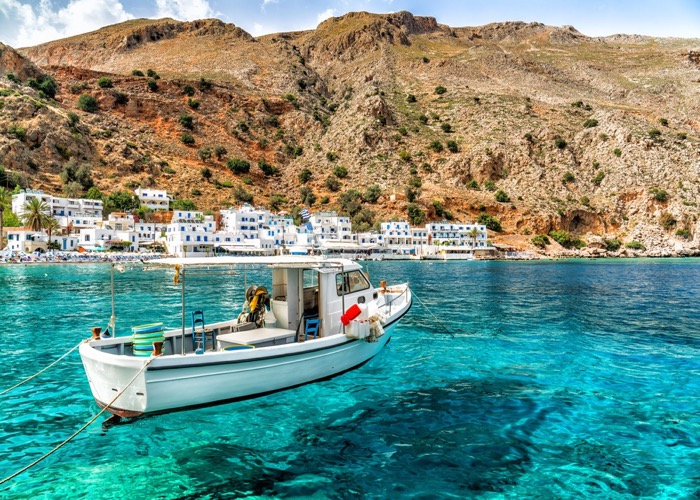
The prefecture of Rethymno is located between Heraklion and Chania.
It is considered by many as one of the most beautiful regions of Crete with imposing mountain ranges and huge sandy beaches on the north coast and south coast of the prefecture.
As a result, it offers many landscape changes and various holiday options.
Rethymno is the most mountainous region of Crete with great growth in the cultivation of olive trees and vegetables.
The scenery that prevails in the area prompts interesting explorations in nature, so whoever has a means of transportation has the opportunity to discover many hidden beauties of the area.
The prefecture of Rethymno is actually the smallest prefecture of Crete with strong historical memories from the time of the Turks and the Venetians.
Due to its geographical location, it served, in the past, as a refuge from various hostile invasions.
The city of Rethymnon is divided into the Old and New Town with the impressive Venetian castle, Fortezza, standing imposingly and offering a nostalgic tour of the past and a panoramic view of the entire sea.
Like the Old Town of Chania, where some of the best hotels in Chania are located, the Town of Rethymnon has a picturesque port with old colorful buildings of Venetian architecture.
The small fishing boats that are scattered in the port give a special charm to the area while there are many beach taverns and cafes to enjoy your coffee or drink, admiring the wonderful scenery around.
Although the Old Town of Rethymnon has not been preserved like the city of Chania, it is still interesting with the historical physiognomy of the area through the narrow alleys and the old Venetian mansions with the wooden balconies and the carved doors.
It is worth touring the streets of the city, to admire the old buildings and the various churches that are scattered around.
For sea lovers, we recommend the beaches of Panorama and Bali, to the north a short distance from the city of Rethymnon, and the beaches of Plakia and Agia Galini in the south of the prefecture.
Surprisingly, there are not many archeological sites in Rethymno, but there are many interesting sites of great historical importance.
Some of them are the cave Ideon Andron, in the central mountain of Psiloritis, where, according to mythology, Zeus was raised when Rhea hid him so as not to be swallowed by his father, Saturn.
The various excavations carried out in the area by archaeologists have highlighted the cave as one of the most important places of worship in the Minoan era.
Another site of historical and naturalistic interest is the heroic Monastery of Arkadi, which is mentioned as a symbol of the revolution of 1821 after it was blown up by the besieged Greeks to escape Turkish slavery.
Chania
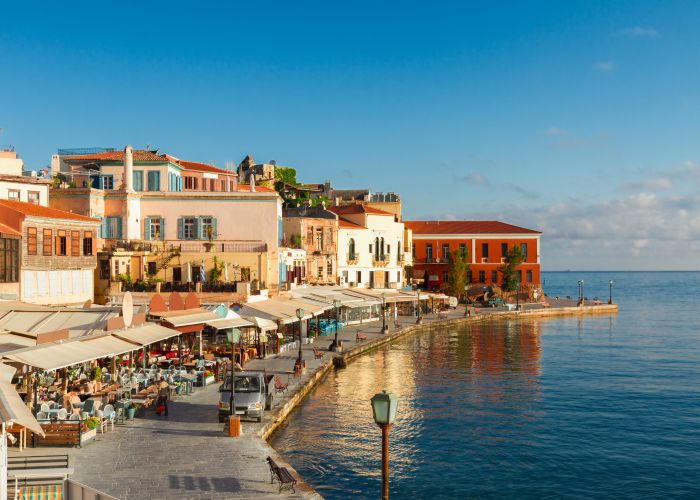
Last but definitely not least, the prefecture of Chania is the westernmost part of the Greek island of Crete and is probably the most popular and impressive of the bunch.
Most of the prefecture is mountainous, thus creating a magnificent setting of mountains and gorges.
Everywhere in Chania, there is a wild natural landscape with dense vegetation and many hundred-year-old trees, such as pines and chestnuts.
In the northern coast of the prefecture, stretches an endless plain surrounded by the White Mountains that is extremely fertile due to continuous rainfall in the mountain range, growing more than 17 million olive and orange trees.
Chania is a magical holiday destination. The traditional city of Chania, the capital of the prefecture and the second largest city of Crete after Heraklion, along with other smaller but picturesque villages scattered around, have much to offer to their visitors -way more than meets the eye.
The city of Chania is the commercial and administrative center of the western region with an important history that began many years ago.
Chania was the capital of the whole of Crete as long as the island was autonomous and didn’t belong to Greece, but also during the first years of its union with the rest of Greece.
The city of Chania consists of two parts - the Old and the New Town. Although the two areas are different, they perfectly combine tradition with modern style.
Chania is beautiful with old Venetian houses and traditional buildings rising in the narrow alleys of the Old Town which is surrounded by the Venetian Castle, an impressive building built in the 15th century AD.
The whole city of Chania with its picturesque harbor, the towering lighthouse, and its narrow streets offers a unique setting as if it came from a colorful postcard.
Walking through the streets of the city and gazing at the old Venetian candles you will be transported to another era.
Everywhere there are picturesque taverns, cafes, and bars to relax and enjoy your drink or try a delicious meal.
In the summer months, you will have the opportunity to enjoy the sun and the sea on the beautiful beaches of Chania when you visit Crete.
In the north of the prefecture, you will find busy, organized beaches while if you want relaxation and wild scenery you will head south and west where you will meet enchanting pristine sandy beaches and picturesque coves with crystal clear waters.
The prefecture of Chania is also famous for the famous Samaria Gorge which is considered a unique natural phenomenon and is the largest in Europe.
Thousands of visitors travel to the island every year to visit it. Many excursions are organized in the summer in the area and it takes about 6 to 8 hours to cross the 18 km long gorge.
The route is reminiscent of a small paradise on earth with mountains, streams, wildlife, and lush vegetation taking the adventurers’ breaths away.
The best time to tour the gorge is the months of May and June before the onset of the great summer heat.
The area has a port and an airport with a high frequency of daily flights, especially in summer, thus facilitating easy access to the prefecture and the surrounding areas.
Crete Landmarks, Sites & Beaches
The island of Crete stretches for more than 350 km from East to West and operates as the southernmost border of Greece and Europe between the Cretan and the Libyan Sea of Africa.
Due to its sheer size, it offers a huge variety of landscapes for the traveler to explore, from snowy mountain ranges, and lavish alpine forests, to palm tree forested gorges and desert-like sceneries.
Let us introduce you to some of the most iconic landscapes of Crete:
Elafonisi
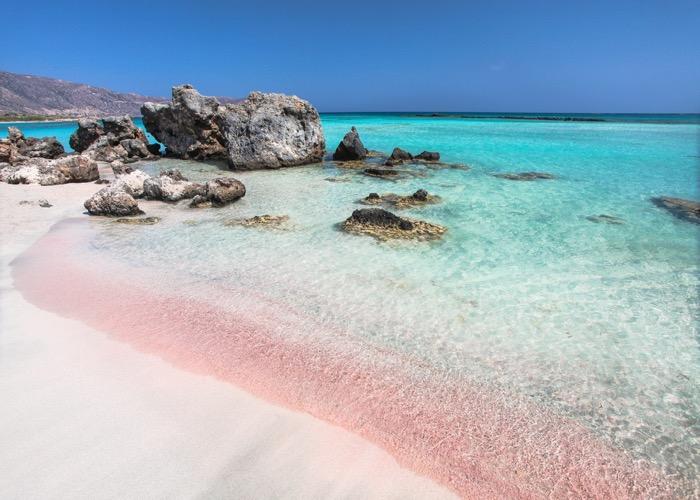
Elafonisi, which literally translates to 'the island of the deer' in Greek, is a tiny island located on the southwest shores of Crete.
Less than 100 meters away from the mainland and dependent on the tides, a narrow strip of sand connects it to Crete.
On your way to Elafonisi, located some 75 km away from the city of Chania, you will pass through a protected 'Natura 2000 natural park' with cedar trees that reach the beach.
Take advantage of the low tide and walk on the pink sand toward Elafonisi, otherwise, prepare to get wet!
Due to its natural beauty, Elafonisi is a really popular destination that can get pretty crowded. Most of the island's south side, though, is covered with pinkish sand creating wonderful beaches long enough to accommodate everyone.
Elafonisi was the set of one dramatic event during the Greek War of Independence in the 19th century.
The rebelled Greeks that fought against the Ottoman Empire, found refuge on the small island along with their families, hiding and waiting for a ship to transport them to the Ionian islands, which were under the protection of Britain.
With the low tide, the Ottoman cavalry reached Elafonisi and slaughtered everyone before they even had a chance to escape.
A small monument at the highest point of the island commemorates the event.
The Samaria Gorge
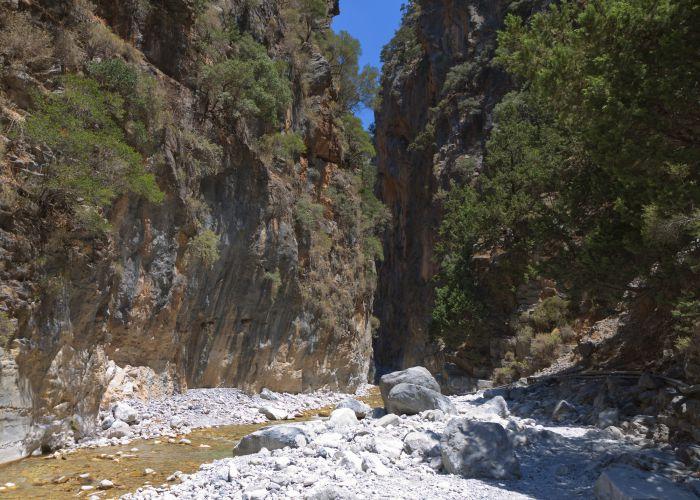
The Gorge of Samaria is a protected National natural landmark and one of the most popular tourist destinations of the county of Chania.
The region is dominated by high mountains the locals call the 'White Mountains' and natural springs forming small rivers that carve their way to the sea creating numerous gorges and a unique landscape.
Home to the indigenous goat known as kri-kri, Samaria is the most accessible gorge to the public offering a wonderful route from Omalos plateau to the port of Agia Roumeli.
The task of crossing the gorge can prove to be quite arduous, especially during the summer months.
It is approximately a 16 km walk -which translates to approximately 6 to 7 hours- down the river through the mountains of south Crete.
If you find the courage to attempt the crossing, prepare beforehand by checking whether the gorge is open to the public and make sure to be at the starting point as early as possible.
This trip is an ideal way for you to experience Cretan nature at its finest!
Reach the Gates, a point where the walls of the gorge have a width of just 4 meters before reaching the end at Agia Roumeli, where a small boat waits for you to get you to Sfakia or to a bus back to Chania.
Balos Lagoon

A place of particular interest and beauty, the Balos Lagoon is a must-see destination for absolutely anyone visiting Crete.
Accessible by ferry from the port of Kissamos or by an off-road route and a trail for the more adventurous ones, Balos offers a memorable day-trip experience.
If you choose to take the ferry, you will have the chance to see the islands of Gramvousa and the Venetian Castle at the top of Imeri Gramvousa.
Enjoy the crystal clear blue and turquoise waters of the Cretan Sea and lay on the pinkish sandy beaches of Balos or explore hidden caves and small coves nearby.
An ideal way to end your day at Balos is with a typical Cretan meal in one of the nearby small restaurants that offer authentic and delicious dishes of Cretan cuisine.
According to CNN, Balos Lagoon is considered to be the 35th-best beach in the world, so you'd better not forget your cameras!
Lake Kournas
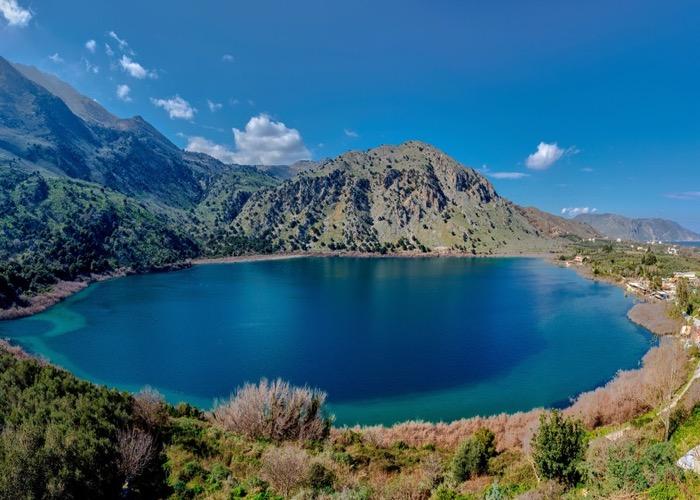
An approximate half-hour car ride west from the city of Rethymnon, Lake Kournas is located at the northern feet of the White Mountains.
It is the only freshwater lake on the island, with a perimeter of about 3.5 km. The lake is linked to many myths and legends of Greek Mythology in the area.
The most popular one speaks of a young maiden that pled to God to save her from rape.
According to the story, this is how the lake was created, and legend says that the ghost of the maiden still lingers there.
The lake is also associated with the ancient city of 'Korion,' with a temple dedicated to the goddess Athena.
Nowadays, the visitor can cool himself down in the clear waters of the lake, rent a pedal boat around the lake, or even walk around it -depending on the water level- and get a free fish spa!
The biodiversity attesting in the region of the lake is impressive (only comparable to Chios - the fifth largest island in Greece- lush mastic tree groves and rugged terrain.
It includes numerous bird species migrating towards Africa to freshwater fish, harmless water snakes, eels, and indigenous terrapins!
A must-see visit for every nature lover, Lake Kournas is an alternative option for you to take into consideration.
Final Thoughts
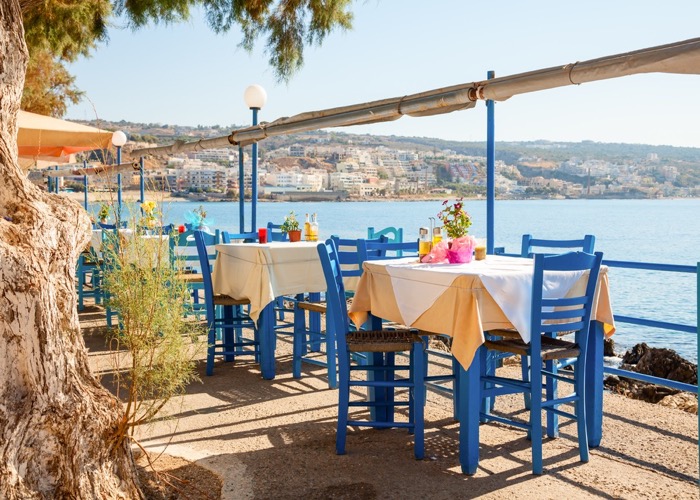 Cretan Tavern - credits: Dmitry Naumov/Shutterstock.com
Cretan Tavern - credits: Dmitry Naumov/Shutterstock.com
Crete is not only the biggest island in Greece but also one of the most fun and diverse destinations in the country.
It has gained popularity due to its impeccable natural beauty, the world-renowned Cretan cuisine, its fascinating history, and the vast variety of experiences it offers to its visitors.
Many pieces of Greek literature have been inspired by the magnificent islands of Crete.
However, unless you take in its carefree vibe and witness its splendor yourself you won’t understand the hype that surrounds its name.
What can we say? Crete is one of those destinations you can’t leave out of your traveling itinerary if cool, heaven-like places are what you’re after, whether you’re visiting Crete with kids, friends, as a couple, or even solo!






